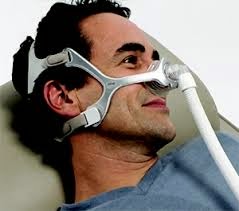 |
| Respironics Go Life nasal pillows are easy to adjust and designed to handle both CPAP and BiPAP prescriptions. |
 |
| Philips Respironics Nuance Nasal Gel Pillow employs comfort gel technology with the same ultra-soft materials used in NICU units to provide a super soft headgear that doesn't irritate skin. |
If you have been given a prescription for CPAP, BiPAP or AutoPAP, you need to check with your physician to see if you can opt for one of the smaller masks available. Note: Not everyone can wear a smaller mask due to facial physiology, facial hair or the amount of pressure necessary for PAP to be successful... but if you have a lower pressure and your facial landscape can support a smaller mask, it might be worth looking into. So go ahead and ask!
There are two main varieties of PAP masks which come in smaller shapes and sizes, often with minimal headgear as well.
NASAL PILLOWS
These small devices aren't technically masks, but small pressure delivery devices which reside right inside your nostrils. For people who do not like the feeling of headgear on the face and scalp, these can be a good option as they offer minimal fitting with headgear.
 |
| ResMed claims its AirFit™ P10 Nasal Pillow is one of the quietest pillow PAP delivery systems available on the market. |
 |
| The ResMed Swift FX for Her has soft headgear and a smaller pillow design for the female face. |
 |
| The ResMed Mirage Swift Nasal Pillow has a unique barrel- shaped pillow design. |
Nasal pillows may require some adjustment to the direct delivery of air pressure through your nostrils, as you cannot get a good return on this form of mask if you normally breathe through your mouth. Often noted in early use of nasal pillows during the initial adjustment period is a feeling of "not being able to breathe out against the incoming air." This is easily addressed, as PAP machines have special settings which can be adjusted to help with exhale pressures while using nasal pillows.
NASAL MASKS
 |
| ResMed's Swift Nano nasal mask is very lightweight and adjusts to different nose bridge lengths. It comes with minimal headgear. |
 |
| The Mirage FX by ResMed is small, stable and fits to most facial features. It has a great reputation for preventing leaks, too. |
 |
| A chin support can help draw the jaw shut until you relearn to breathe only through your nose while using PAP therapy, which is how you should breathe naturally. |
Those who breathe through their mouth may try using smaller mask options if they are willing to also use a chin support device in order to preserve the pressure therapy they have been prescribed. Chin supports help keep the jaw aligned and prevent the mouth from opening and breaking the critical pressure seal that is the key feature of PAP therapy.

